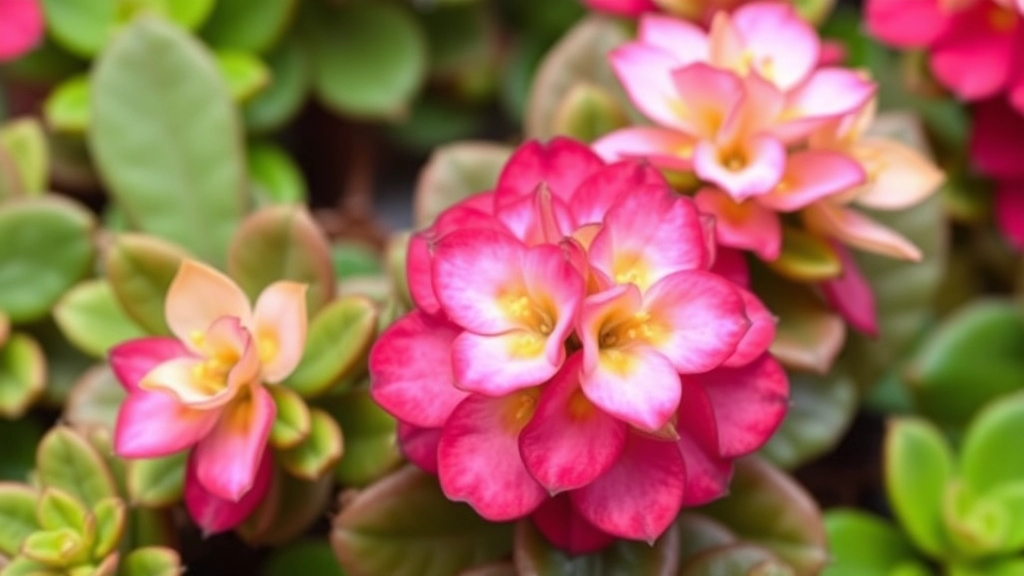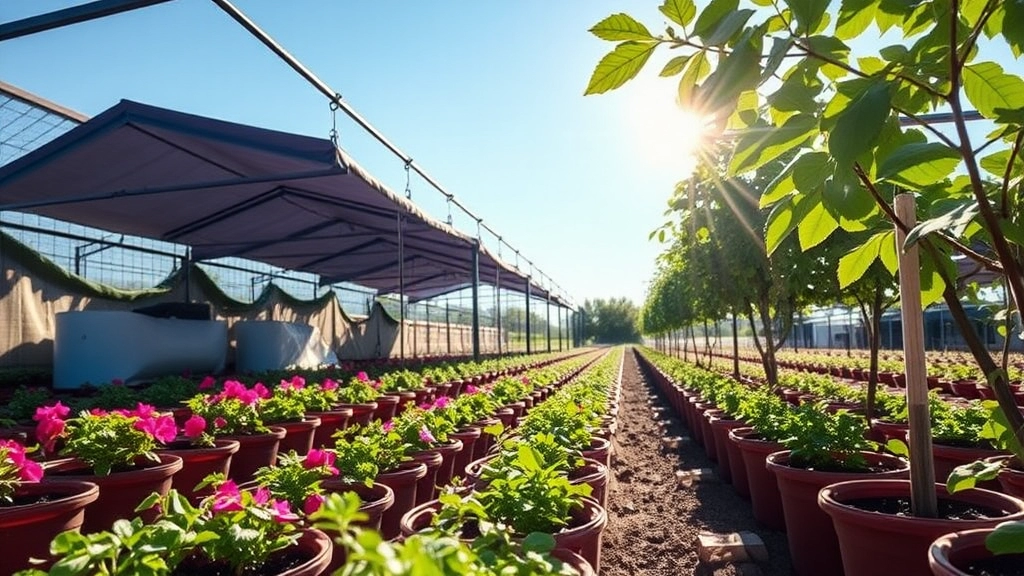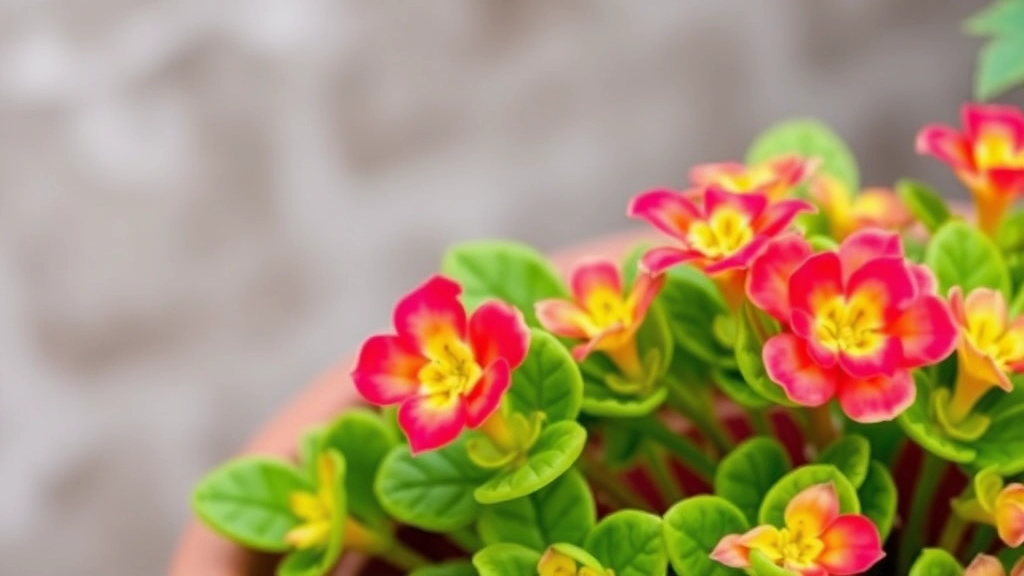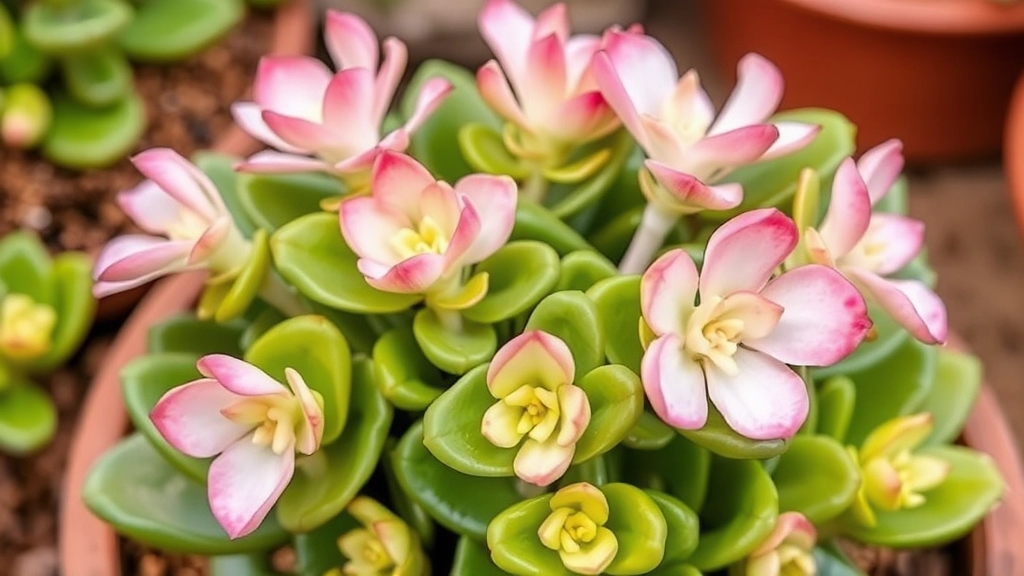Caring for Kalanchoe Tubiflora Maternity Plant
Ever wondered how to care for a Kalanchoe Tubiflora Maternity Plant, also known as the “Mother of Millions”? This unique succulent is a favourite among gardeners for its easy propagation and striking appearance. Let’s dive into the essentials of growing and maintaining this fascinating plant.
Understanding the Characteristics
First off, understanding the characteristics of the Kalanchoe Tubiflora is crucial. This plant thrives in well-draining soil and requires minimal watering, making it perfect for both beginners and seasoned gardeners. However, be mindful of its invasive nature and potential toxicity to pets and children. Ready to learn more? Let’s get started on creating the perfect environment for your Kalanchoe Tubiflora.
Characteristics of Kalanchoe Tubiflora
Are you curious about what makes Kalanchoe tubiflora such a fascinating plant?
Kalanchoe tubiflora, often known as Mother of Thousands, is a succulent renowned for its unique features.
Optimal Growing Conditions for Kalanchoe Tubiflora

So, you’ve got your eye on Kalanchoe Tubiflora, and you’re wondering how to create the perfect environment for it.
This plant thrives in conditions that mimic its native habitat, so let’s break it down into simple, actionable tips.
Location, Location, Location
- Indoors or Outdoors? Kalanchoe Tubiflora can grow happily both indoors and outdoors. Just ensure it gets enough light, especially if you’re keeping it inside.
- Potting Up: Use a pot with drainage holes to prevent waterlogging. A terracotta pot is a great option as it allows the soil to breathe.
Soil Type
- Well-Draining Soil: A cactus or succulent mix works wonders. You can also make your own by mixing regular potting soil with sand or perlite.
- pH Level: Aim for a slightly acidic to neutral pH (around 6.0 to 7.0).
Temperature and Humidity
- Ideal Temperature: Kalanchoe loves warmth! Keep it between 20°C to 25°C during the day and not lower than 10°C at night.
- Humidity Levels: This plant prefers low humidity. If you live in a humid area, ensure good air circulation.
Light Requirements
- Bright, Indirect Light: It thrives in bright, indirect sunlight. Too much direct sun can scorch the leaves.
- Supplemental Lighting: If natural light is scarce, consider using grow lights.
Watering and Soil Needs
When it comes to caring for Kalanchoe Tubiflora, understanding its watering and soil needs is crucial for its health and growth. Are you worried about overwatering or choosing the right soil? You’re not alone; many plant enthusiasts share these concerns.
Watering Guidelines
Kalanchoe Tubiflora thrives in a well-draining environment, so proper watering is essential. Here are some key tips to keep in mind:
- Frequency: Water your Kalanchoe Tubiflora every 2-3 weeks during the growing season (spring and summer). In winter, reduce watering to once a month.
- Method: Always check the top inch of soil; if it feels dry, it’s time to water. Ensure that excess water drains out to prevent root rot.
- Signs of Overwatering: Yellowing leaves and mushy stems are red flags. Adjust your watering schedule if you notice these symptoms.
Soil Requirements
Choosing the right soil is equally important for your Kalanchoe Tubiflora. Here’s what you need to know:
- Type: A well-draining cactus or succulent mix is ideal. You can also create your own by mixing potting soil with sand or perlite in a 2:1 ratio.
- pH Level: Aim for a slightly acidic to neutral pH (around 6.0 to 7.0) to support healthy growth.
- Container: Ensure your pot has drainage holes. This will help prevent water from accumulating, which can lead to root issues.
For more detailed care tips, you might find our essential care tips and tricks for growing Kalanchoe especially useful. Additionally, if you are interested in other varieties, check out our comprehensive guide to Kalanchoe Paddle Plant care.
Sunlight and Temperature Requirements

When it comes to growing Kalanchoe Tubiflora, understanding its sunlight and temperature needs is crucial.
Many plant enthusiasts often wonder, “How much sunlight does my Kalanchoe need?” or “What temperature is ideal for its growth?”
Sunlight Needs
Kalanchoe Tubiflora thrives in bright, indirect sunlight. Here are some key points to consider:
- Direct Sunlight: While it can tolerate some direct sunlight, too much can scorch its leaves.
- Ideal Location: A south or west-facing window is often the best spot, providing ample light without the harsh rays.
- Signs of Inadequate Light: If your plant becomes leggy or its leaves start to drop, it may not be getting enough light.
Temperature Requirements
Temperature plays a significant role in the health of your Kalanchoe. Here’s what you should know:
- Optimal Range: This succulent prefers temperatures between 18°C to 24°C (65°F to 75°F).
- Cold Sensitivity: It’s sensitive to cold and should be kept away from temperatures below 10°C (50°F).
- Seasonal Changes: During winter, ensure it’s in a warm spot, as drafts can be detrimental.
Propagation Methods
When it comes to Kalanchoe Tubiflora, many plant enthusiasts often wonder how to propagate this resilient succulent effectively.
Controlling Invasiveness

Have you ever wondered how to keep Kalanchoe Tubiflora from taking over your garden? You’re not alone! This plant, with its vibrant leaves and easy care, can become a bit too enthusiastic in its growth.
Understanding Its Nature
Kalanchoe Tubiflora is known for its ability to spread quickly. If left unchecked, it can outcompete other plants, leading to an invasion. Here’s how you can manage its growth effectively:
- Regular Pruning: Trim back the stems regularly to keep the plant in check. This encourages bushier growth and prevents it from becoming leggy.
- Container Gardening: Consider growing it in pots rather than directly in the ground. This confines its roots and limits its spread.
- Remove Offsets: This plant produces small plantlets at the edges of its leaves. Collect and dispose of these before they take root elsewhere.
- Mulching: Applying a thick layer of mulch can help suppress unwanted growth around the base of the plant.
- Monitor Growth: Keep an eye on its spread. If you notice it encroaching on other plants, take action immediately.
By using these strategies, you’ll maintain control over your Kalanchoe Tubiflora, ensuring it remains a beautiful addition to your garden without becoming a nuisance.
As we delve deeper into caring for Kalanchoe tubiflora, it’s essential to address the common pests and diseases that can affect this resilient plant.
### Pests to Watch For:
– **Aphids**
Small, soft-bodied insects that suck the sap from your plant.
Look for curled leaves or sticky residue on the leaves.
– **Mealybugs**
White, cotton-like clusters found in leaf axils.
They can cause yellowing and wilting of leaves.
– **Spider Mites**
Tiny, spider-like creatures that thrive in dry conditions.
Check for fine webbing and speckled leaves.
– **Scale Insects**
Hard, shell-like bumps on stems and leaves.
They can lead to stunted growth and leaf drop.
### Diseases to Be Aware Of:
– **Powdery Mildew**
A white, powdery fungus that appears on leaves.
Often caused by high humidity and poor air circulation.
– **Root Rot**
A result of overwatering, leading to mushy roots.
Signs include yellowing leaves and wilting.
– **Leaf Spot**
Dark, water-soaked spots on leaves.
Usually caused by fungal infections.
### Prevention and Control:
– **Regular Inspection:**
Check your plants weekly for early signs of pests or diseases.
– **Proper Watering:**
Avoid overwatering to prevent root rot. Ensure good drainage.
– **Air Circulation:**
Keep plants spaced to allow airflow, reducing humidity-related issues.
– **Natural Remedies:**
Use insecticidal soap or neem oil for pest control.
For more detailed care tips, you might find our [complete guide to growing and caring for succulent plant Kalanchoe](https://planthq.org/ultimate-guide-to-growing-and-caring-for-succulent-plant-kalanchoe/) useful. Additionally, if you’re dealing with specific issues like leaf spot, our guide on [how to treat black spots on Kalanchoe leaves](https://planthq.org/how-to-treat-black-spots-on-kalanchoe-leaves/) offers effective solutions.
Safety and Toxicity Concerns of Kalanchoe Tubiflora

Now that we’ve covered how to care for your Kalanchoe Tubiflora, let’s talk about something that often gets overlooked: safety and toxicity.
You might be wondering, “Is this beautiful plant safe to have around my pets or kids?”
Well, here’s the scoop: Kalanchoe Tubiflora is indeed toxic.
Toxicity Overview
- Toxic Components: The plant contains compounds known as bufadienolides, which can be harmful if ingested.
- Symptoms of Toxicity: If your pet or child munches on a leaf, they might experience:
- Vomiting
- Diarrhoea
- Lethargy
- Heart arrhythmias (in severe cases)
Precautionary Measures
To keep your home safe, consider these tips:
- Placement: Keep your Kalanchoe Tubiflora out of reach of children and pets.
- Education: Teach kids about the plant and why it’s not a snack.
- Alternatives: If you’re looking for safe houseplants, consider options like spider plants or peace lilies.
What to Do in Case of Ingestion
If you suspect ingestion, don’t panic!
- Contact a Vet or Doctor: They can provide guidance based on the situation.
- Keep the Plant Handy: Having a sample of the plant can help professionals identify the issue quickly.
Seasonal Care Tips for Kalanchoe Tubiflora
As we transition through the seasons, caring for your Kalanchoe Tubiflora requires attention to specific needs that change throughout the year. By understanding these seasonal variations, you can foster a thriving plant that brings joy and beauty to your space.
Spring: Awakening Growth
In spring, your Kalanchoe Tubiflora will begin its active growth phase. Here are some essential tips:
- Repotting: If your plant has outgrown its pot, consider repotting it in fresh soil to encourage healthy growth.
- Fertilising: Use a balanced, water-soluble fertiliser every four to six weeks to promote vibrant blooms.
- Pruning: Trim any dead or yellowing leaves to encourage new growth.
Summer: Sun and Water
During the summer months, your plant will need extra care:
- Watering: Increase watering frequency, ensuring the soil dries out between sessions. Aim for a deep soak to encourage strong roots.
- Shade: If temperatures soar, provide some afternoon shade to prevent leaf scorch.
- Pest Check: Regularly inspect for pests, as warmer weather can invite unwanted guests.
Autumn: Preparing for Dormancy
As temperatures begin to cool, your Kalanchoe Tubiflora will start to slow down:
- Reduce Watering: Cut back on watering, allowing the soil to dry out more between sessions.
- Fertiliser: Stop fertilising to let the plant prepare for its dormant phase.
- Clean Up: Remove any fallen leaves or debris to prevent disease.
Winter: Minimal Care
In winter, your plant enters a dormant state, requiring minimal intervention:
FAQs About Kalanchoe Tubiflora (Maternity Plant)
What are the optimal growing conditions for Kalanchoe Tubiflora?
Kalanchoe Tubiflora thrives in conditions that mimic its native habitat. Ensure it gets enough light, whether indoors or outdoors, and use a pot with drainage holes. A cactus or succulent mix works well for soil, and the ideal temperature range is between 20°C to 25°C during the day and not lower than 10°C at night. Low humidity is preferred.
Where should I place my Kalanchoe Tubiflora for the best light?
Place your Kalanchoe Tubiflora in bright, indirect sunlight. A south or west-facing window is ideal. If natural light is scarce, consider using grow lights. Too much direct sunlight can scorch its leaves.
What type of soil is best for Kalanchoe Tubiflora?
Well-draining soil is crucial. A cactus or succulent mix is ideal, or you can make your own by mixing regular potting soil with sand or perlite. Aim for a slightly acidic to neutral pH (around 6.0 to 7.0).
How can I prevent my Kalanchoe Tubiflora from becoming invasive?
To control its spread, regularly prune the stems, grow it in containers, remove offsets, apply mulch around the base, and monitor its growth. These strategies will help keep the plant in check.
Is Kalanchoe Tubiflora toxic to pets and children?
Yes, Kalanchoe Tubiflora is toxic. It contains compounds known as bufadienolides, which can be harmful if ingested. Symptoms of toxicity include vomiting, diarrhoea, lethargy, and in severe cases, heart arrhythmias.
What should I do if my pet or child ingests Kalanchoe Tubiflora?
If ingestion occurs, contact a vet or doctor immediately. Keep a sample of the plant handy to help professionals identify the issue quickly. In the meantime, keep the plant out of reach and educate children about its toxicity.
Can Kalanchoe Tubiflora tolerate cold temperatures?
No, Kalanchoe Tubiflora is sensitive to cold. It should be kept away from temperatures below 10°C (50°F). During winter, ensure it’s in a warm spot, as drafts can be detrimental.
How can I ensure my Kalanchoe Tubiflora gets enough light indoors?
If natural light is insufficient, use grow lights to supplement. Place the plant in a bright, indirect light spot, such as near a south or west-facing window. Signs of inadequate light include leggy growth and leaf drop.
What precautions should I take to keep my home safe with a Kalanchoe Tubiflora?
To ensure safety, place the plant out of reach of children and pets, educate kids about its toxicity, and consider safer houseplant alternatives like spider plants or peace lilies.
References
-
Growing Kalanchoe Tubiflora: Tips and Tricks
-
Kalanchoe Tubiflora Care Guide
-
Kalanchoe Tubiflora – North Carolina Extension Gardener Plant Toolbox
